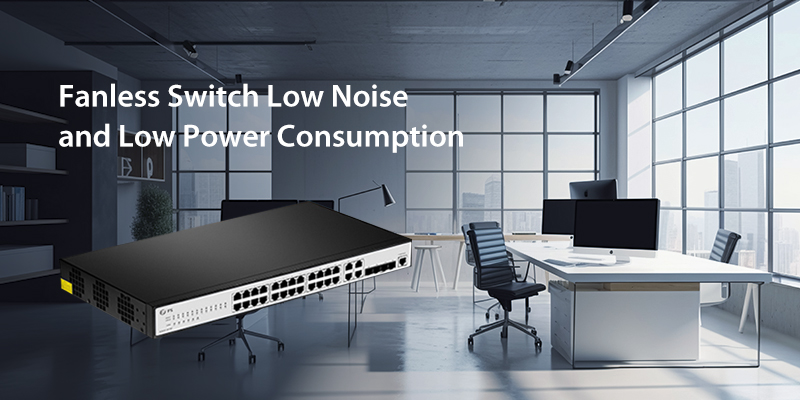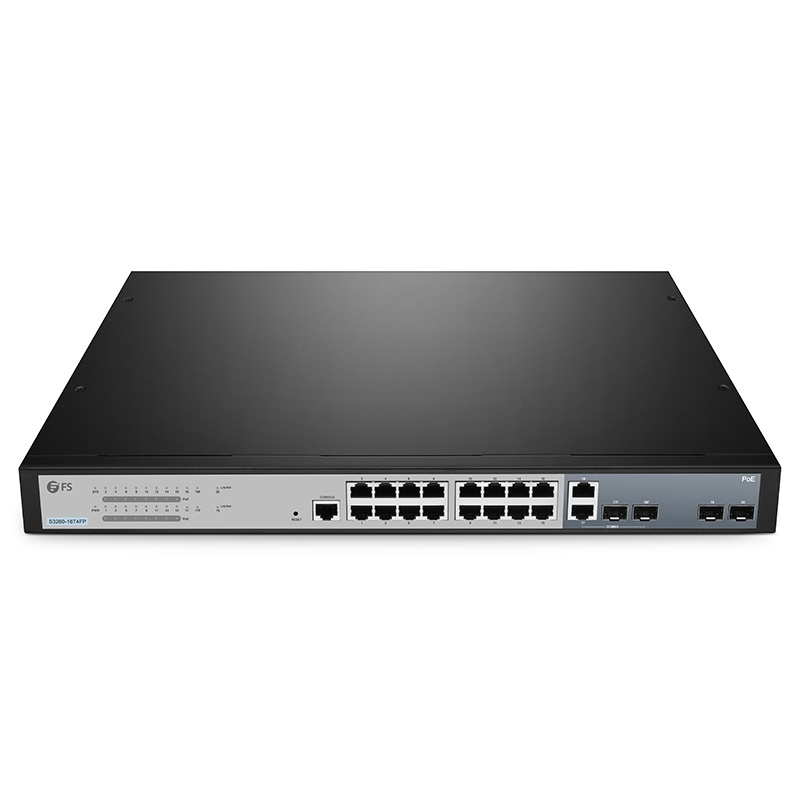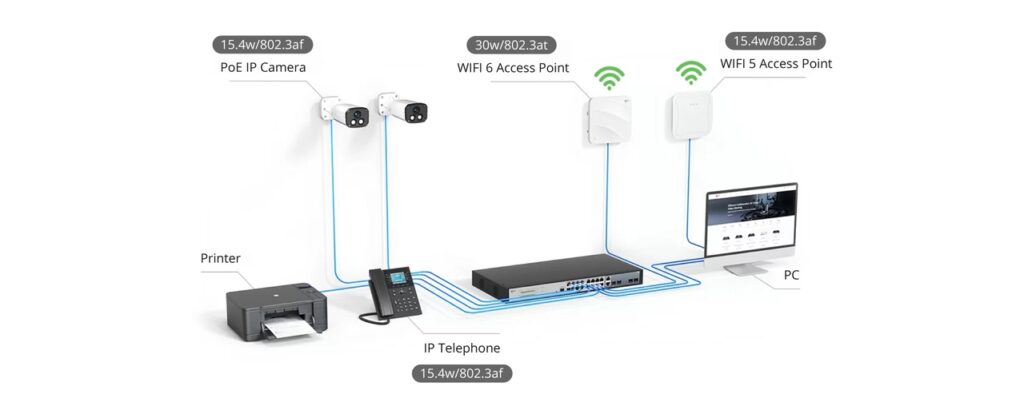Currently, SMB networks tend to choose PoE switches to build LAN networks to achieve efficient network transmission and management. Based on this, various PoE switches have appeared on the market. If you are wondering how to choose the right PoE switch for your enterprise, please read this article. We will give you the answer.
A Brief Intro ——PoE Switch and SMB Network
Compared with other switches, a PoE switch is a network switch that supports Power over Ethernet (PoE) technology and can provide power to PoE devices connected to it. PoE switches allow data and power to be transmitted on the same Ethernet cable without the need for additional power lines. This is very convenient for intelligent systems in SMB networks, such as IP cameras, wireless access points, Internet phones, etc.
Types of PoE Switch
Here are several PoE switch types and their applications in SMB networks:
Unmanaged PoE Switches: Unmanaged PoE switches offer fixed network management configurations and are ideal for small businesses that only require a basic PoE network.
Smart Managed PoE Switches: Smart managed PoE switches, also known as hybrid PoE switches, are a type of intermediary that provides simple configuration through a web browser management interface.
Managed PoE Switch: It is the best-in-class type and they are generally designed to provide you with complete management of your network for great performance and increased security.
SMB Network Challenges
SMB networks are generally less complex than large enterprise networks, and they may include one or more servers, switches, routers, firewalls, and endpoint devices. SMB enterprises have limited IT resources and personnel, which can lead to challenges in managing and maintaining the network. In addition, enterprises are relatively small and network needs may be elastic and need to be able to adapt to rapid changes in the business.Therefore, SMBs usually face some of the following challenges:Network Performance Issues: When the number of end devices increases, you may face network congestion and performance issues.Security Challenges: Lack of professional security measures can leave the network vulnerable to malicious attacks.Device Compatibility: Devices from different manufacturers may need to work together in the network, and ensuring device compatibility and stability can be a challenge.Network Management Complexity: Even with relatively simple networks, managing end devices, user permissions, and network policies can still become complex.Technical Support: SMBs typically do not have a dedicated IT team, so they may need to rely on outside technical support.
Key Factors to Consider in PoE Switches Purchasing
Transmission Rates
The data rate of the PoE switch determines the speed of data transmission from the edge device. Matched network speeds resolve latency issues and increase work productivity and efficiency. PoE switches typically serve Fast Ethernet 10/100Mbps and Gigabit networks. Although 10/100Mbps PoE switches are suitable for SMB networks, as application performance improves, such as IP HD cameras, WiFi 6 access points, and Internet of Things (IoT) devices, the demand for high bandwidth increases. For enterprises with higher bandwidth requirements, it is wise to choose a PoE switch that supports Gigabit networks, and even consider super-10 Gigabit models.
Business Demands
Due to the different sizes of SMB, PoE switches are designed with different numbers of ports. It depends on the size of the business, so it’s important to know how many wired devices are connected using Ethernet. These devices include computers, printers, access points, and other devices that need to be connected to a PoE switch. Typically, the number of ports supported by a PoE switch varies between 5 and 48.
Power Consumption
Ensuring seamless data transfer in SMBs without worrying about power or signal loss is crucial. Connecting power supply network devices and performing complex total power budget calculations are critical steps.Standard PoE switches follow the IEEE802.3 standard and provide different output powers: IEEE802.3at is 15.4W, IEEE802.3af has a maximum output power of 30W, and IEEE802.3bt can output up to 100W. Device power consumption specifications make it easy to determine the required standard, basically choosing based on the device’s maximum power requirements.In addition, PoE switches have different total power budgets, and carefully calculating all connected devices is the most direct and effective way to determine the required power budget.
Devices Compatibility
PoE compatibility issues in SMB networks are a key consideration. Generally speaking, PoE switches function when connected to other PoE devices. The specifics may vary. For those considering using a PoE switch to connect non-PoE devices or wishing to integrate an existing non-PoE switch with a PoE switch, they must pay attention to the PoE compatibility of the PoE switch.Surely, there are many other factors that will affect the choice of PoE switches, such as deployment, future expansion, etc., which all need to be considered when building a network.
Finding the Suitable PoE Switch for SMB Network
If you are choosing a PoE switch for your IP surveillance system, go for a PoE switch equipped with 8 ports or 24 ports. 10/100Mbps PoE switches can be well adapted to IP surveillance video data transmission. Because the network speed consumption of high-definition cameras is about 25Mbps, even super-type 4K cameras only require network speeds of about 10Mbps.For PoE wireless access points, larger bandwidth is required to ensure smooth WiFi access. WiFi 6 allows business owners to achieve 1G/2.5G ultra-high-speed WiFi. To ensure this functionality is achieved, it is critical to select a PoE switch capable of delivering 1G/10G or faster network speeds.Today, businesses rely more on the Internet to hold meetings locally or globally. VoIP conferences often have higher requirements for network bandwidth, management and security. You’re better off choosing PoE switches that offer gigabit and faster network speeds while supporting QoS performance.
| Switches | S2805S-8TF-P | S3150-8T2FP | S3400-24T4FP | S3410-48TS-P |
| Ports | 8x 10/100/1000BASE-T RJ45|2x 1G SFP | 8x 10/100/1000BASE-T RJ45 | 2x 1G SFP | 24x 10/100/1000BASE-T RJ45 | 4x 1G RJ45/SFP Combo | 48x 10/100/1000BASE-T RJ45, 2x 1G RJ45/SFP Combo | 2x 1G/10G SFP+ |
| PoE Budget | 140W | 130W | 370W | 740W |
| PoE Standard | IEEE 802.3af/at | IEEE 802.3af/at | IEEE 802.3af/at | IEEE 802.3af/at |
| Design | 1 Built-in Fan | Fanless | 3 Built-in Fan | 2 Built-in Fan |
| Protocal | VLAN, QoS, IGMP, LACP | ACL, QinQ, QoS, ERPS | ACL, QinQ, QoS, ERPS | ERPS, QoS, OSPF, LACP |
Conclusion
There are many types of PoE switches in SMB networks, and understanding these can help you choose the appropriate equipment for your business. A variety of PoE switches may be needed to meet actual needs, and selection should not be made hastily to avoid unnecessary downtime costs. FS provides PoE switches that adapt to business needs and support advanced functions such as QoS/LACP/ERPS. If you have questions about purchasing a PoE switch, please visit FS.com for more information.














